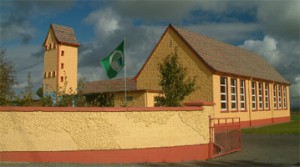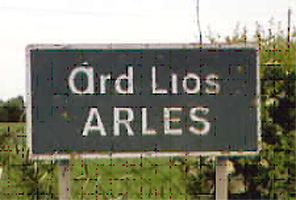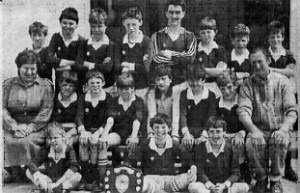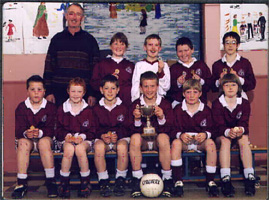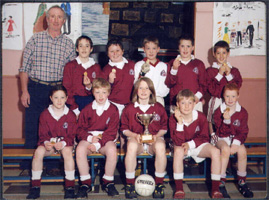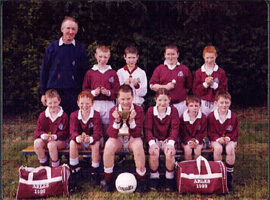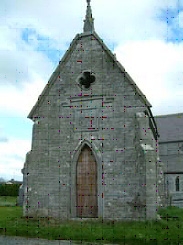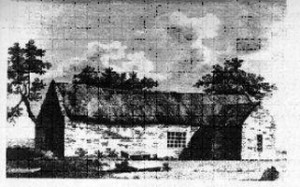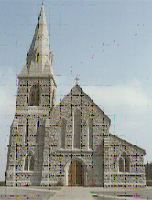Arles National School
Arles National School was opened and blessed by Monsignor Conway in June 1961. It replaced the old school built in the church grounds in 1836. The first pupils in the new school moved from the old school on 1/9/1961.
The first principal of the new school was Mr. James Harney who moved from the old school. He lived in the teacher’s residence in Arles. He retired in July 1976. He was succeeded by Mr.Michael Dennehy until December 1978. Mr. Dennehy was succeeded by Principal Mrs. Killoran in January 1979. Mrs. Killoran retired in 2006 and Ms. Marianne Murphy- Brady was the principal until 2011. Mrs. Fitzpatrick, who started in March 2011, is the current Principal.
In summer 1975 the Rushes school was closed. On 1/9/1975 the children from the Rushes school were transferred to Arles school by bus and this practice continues to the present.
Due to the big increase in pupils in the school, Arles school had to be extended. Two new classrooms and a general practice room were added to the school. This work was completed by summer 1984. For two years before this, the senior classes had classes upstairs in the old school in the church grounds. In 2006, the school was further extended by one classroom. The first manager of the school was Fr. Coughlan. He was succeeded by Fr. Kennedy, Fr. Deady, Fr. O’Shea and Fr. P.J. Madden. Mr. Francis Egan is the current Chairperson of the Board of Management.
Our local place names have a connection with our native Irish Language which is part of our heritage. We researched our local place names and found the English names come from the Irish name.
Ardlios
Ardlios is Irish for Arles. The old title for the parish is Killabban. It got its name from the parish church being placed in modern times at Arles. The name Arles comes from “Ard Glas”, “The verdant hill” or “Green hill” or according to some from Ard Lios “The forted hill” or “High Fort”. The name Ard Lios “The high fort” is peculiarly appropriate. Rising from encircling plains to a height over one hundred feet its sides in former times were thickly clothed with scrub and underwood.
Radharc Álainn which means “Beautiful View” in a housing estate built opposite the school and gets its name from the site it is built on.
Irish Translations of Arles
An Ard-lios: “The High Ring Fort or The Fortified Hill”
or
An Ard-glas: “The Verdant Hill”
Religious Heritage
Our Religious heritage centres on our local parish church – The Church of the Sacred Heart Arles. The beautiful marble high altar, the Reredos, the two side altars, the stained glass windows and the well planned interior of the church focus the mind on our great religious heritage.
Arles Parish Church was completed in 1868. Our great great grandparents deserve great credit and our gratitude for building such
a beautiful church in Arles so long ago.
In doing so they passed on their rich heritage of faith to us. We owe it to them to pass on that same heritage to our children. All this shows the continuing religious heritage of our parish going back hundreds of years.
Our religious heritage goes back to St. Abban in the 7th century and before that to St. Patrick. The graves of the dead generations surround the church. They too are part of our religious heritage. Much of the writing on the old headstones can no longer be read. Nevertheless all are remembered after Mass each Sunday and at a special Cemetery Sunday each year.
Arles Around The Time Our Church Was Built
Before the Great Famine in Ireland there were about 40 houses in Arles and 200 people.
Tile making for roof and floor was the thriving local industry until slates came on the market and put an end to that business about 1840. The manufacturing of yarn and linen was carried on to a small extent.
In 1910 there were two shopkeepers in Arles, Thomas McDonald and John Purcell.
Bread, which was a penny a loaf, was baked by Thomas McDonald daily.
The old Arles National School now a hall was built in the chapel grounds in 1836.
Rented from landlord, the Earl of Kenmare. Building was valued at £7 and land was 5 shillings. In total £7-5 shillings (€9.21). The area was I rood and 20 perches.
The Roman Catholic Church and graveyard was also rented land and the payment to the Earl of Kenmare was £1-5 shillings (€1.59), building was valued at £15 (€19.05), the area was 1 acre, 3 roods and 18 perches.
The Religious Heritage of St. Abban
St. Abban is very much part of our local religious heritage. At an early age he joined the monastery of St. Fiach at Sletty which was established around 640 A.D. After completing his studies at Sletty he left to build his own first monastery about 5 miles away at Killabban in the late 640’s A.D. The parish of Arles was known in older times as the parish of Killabban, Cill Abainn or the church of Abban.
Tradition has it that a pilgrim path went from Killabban to a holy well known as St. Abban’s Well. This well is situated only two fields away from Arles Parish Church (on land owned by Pat Mulhall, a local farmer). Each year a parish pilgrimage takes place to St. Abban’s Well on the 15th August. This pilgrimage recalls our ancestors who made their way to this holy well on their way to Sunday Mass. They secretly attended Mass because it was forbidden to attend Mass during penal times when the priests were hunted. Tradition has it that a priest was caught and hung nearby.
There is a common link between us and St. Abban. Tradition has it that he blessed this well in the 7th century. It has never been known to run dry. The greatest unbroken link between us and St. Abban is the common bond of our Christian heritage.
The Old School in Arles
The British government started building primary schools in Ireland after 1829. The old Arles National School built in 1836 was one of the first in the area and it continued to be used until 1961 when the new school was built. The old school built beside the church was a two storey building with outside toilets. There were steps on the outside of the building which led up to the second floor. This school had old iron desks, only one blackboard, a bare wooden floor and a simple open fire. The building was very draughty. One of the old classrooms upstairs was used as a classroom while Arles school’s extension was being built in the 1980’s. The extension was finished in 1985.
The old school is now a community hall. Many of the people who use this hall went to school there. It is used for I.C.A. and G.A.A. meetings. The I.C.A. holds classes there. The G.A.A. holds training sessions there in winter. The Parents’ Association holds meetings there too. Teas and refreshments are given there after funerals.
The Rushes School
The Rushes school got its name because of all the rushes that grow in that area. There was a small village in the area called the Bull Ring where about 34 families lived. Most of them worked in the coal mines. In 1807, Sir Charles Henry Coote Bart built a school near the village. The village has since disappeared. The Rushes School was built in 1900.
This school was a two storey with an outside stairs up to the top room. There were two outside toilets. There was a fuel house. A fire had to be lit every morning to keep the school warm. Some of the teachers’ names were: Mrs. Hughes, Miss Doyle, Miss Bambrick, Mrs. Graham and Mrs. Knowles. There was no running water and water had to be brought from the well. Some of the childrens’ parents went to this school. My teacher Mrs. Killoran went to this school.
Mass was also held in the Rushes school a few times a year. Fr. Killian had the altar put upstairs in the Rushes. Priests in the parish that Grandad remembers were: Fr. Killian, Fr. Byrne, Fr. O’Donnell, Fr. Coughlan, Fr. Deady and Fr. Kennedy.
The community uses the school as a hall now. Whist is played weekly in the Rushes Hall.
The Technical School
Fr. Killeen showed great wisdom in building a technical school in Arles. It was built in 1937. Young girls who had finished primary school could go to the Technical school to learn needlework and domestic science in the evenings. Young boys attended the Technical school to learn woodwork, metalwork and technical drawing. These young boys helped out on the farms and those that did not live on a farm got seasonal work with farmers, sowing seed and saving hay and harvesting beet for Carlow sugar factory. Paddy Kelly and his brother Sean worked for 10 years with local farmer Mick McDonald in Ashfield after they left primary school. Some children attended primary school until they were 16 years of age. Attending the Technical school gave many young men and women useful skills for life. The Technical School had beautiful gardens. It was used to give teas after funerals. Dances were held there. It is now known as Munnelly’s garage.
Farming Heritage
Farming is part of our local heritage for centuries. This is mainly a farming area still. Most farmers here still do mixed farming but it is more specialised e.g. dairy farming and beet growing and dry stock. Big changes have taken place in farming in our local area since Ireland joined the EU. Small farms have been bought up to make bigger farms. Machinery has replaced the seasonal workers of long ago. However, while farmers here have bigger herd numbers, milk quotas and beet acreage than before mixed farming is still part of our local heritage.
Gaelic Football Heritage in our School
Gaelic football is part of the life and heritage of Arles N.S. In recent years, we have been involved in eight finals – we have won six of these finals (1987, 1992, 1997, 1998 ,1999and 2001).
In 1997, we won a Cumann na mBunscol final. We played against Clonaghadoo in the final and it was an excellent sporting contest. We played five matches before the final. We had a great team and we were hoping to win the final after the defeat against Castlecuffe in 1996.
In 1998, we won the Cumann na mBunscol final for the second consecutive year. It was the best result our school had ever achieved in the Cumann na mBunscol. We played against Camross and won by eight points. We were delighted.
In 1999, we were hoping to repeat this victory and to our fortune, we won the final! The scores were very good (There were also some great goals). There was great excitement when we won it for the third time. We played against Shanahoe and it was a close contest!
In 2001 we won the Cumann na mBunscol for the 6th time. We played against Camross. It was a very tough game. Our captain on the day was Andrew Brennan. Camross were a big team. In the end we won by a point after a hard fought game. We were delighted after winning the Cumann na mBunscol final again. The one link in our school’s success in Cumann na mBunscol competitions over the last 20 years was Larry Wall, He also trained the Arles team to win the Co. Laois Senior Football Final in 2003. He was on the first Arles team formed in 1960.
In 2008, our school team reached the finals in Cumann na mBunscoil and took the county title in 2009. Eddie Mulhall now trains the Boys and Denise Fenlon trains the Girls. Both teams reached the Cumann na mBunscol Finals in 2012. In 2013, history was made when both Arles Boys and Arles Girls won the Cumann na mBunscol Finals.
Gaelic Football in our Local Area
– The club was formed in October 1960.
– It won the Co.Laois Junior Cup in 1965, Intermediate Cup in 1967 and then went Senior.
– Arles Club got to the County semi-finals in 1968 and 1974, beaten by a point each year.
– The club competed at Laois Senior County level between 1968 and1986. John Conway was its most famous player, among others.
– The club went through a lean period from 1986 to 1994.
– In 1995 a young Arles team won the County Laois Junior A Final.
– In 1996 Arles won Co. Laois Junior B Final and Chris Conway from the club won the All-Ireland minor medal with Co. Laois.
– In 1999 Chris Conway from the club won the All-Ireland Intermediate Final.
– In 2001 the club was joined by Kilcruise and became known as the Arles/Kilcruise G.A.A. Club.
– In Nov. 2003 the club won the County Laois Senior Football Final for the 1st time beating Stradbally by 0-8 to 0-7. History was made that day.
– Chris Conway and Ross Munnelly from Arles/Kilcruise Club are on the County Laois Panel now and for the past few years.
Children from Arles N.S. cheering for Arles/Kilcruise in the Senior Championship Final 2003
The Grace Mausoleum
Mausoleum means a large monumental tomb.
The Grace family were the descendants of William Fitzgerald who accompanied Strongbow to Ireland in 1169.
A branch of the family came to Co. Laois over 200 years ago and settled in Gracefield, Ballylinan, Co. Laois just 4 miles from Arles Parish Church.
Many of the Graces are buried in the Grace Mausoleum beside Arles Parish Church.
The Grace family were very generous to the Catholic Church in Arles.
Mrs Mary Grace paid £1,500 (€1905) which was half the cost towards the building of Arles Church in 1868. Only for her we might not have our church.
Earlier Churches and History of the Sacred Heart Church Arles
The earliest Chapel on this site was built in 1686 by a lady of the Hartpole family. An inscribed stone in the wall of the present Church records the building of this old Chapel in the 1680’s. This Church was cruciform and thatched. In 1795 this structure was replaced by another Church, which in turn, was replaced by the present beautiful Church in 1868.
The present church is a most impressive structure, whose height is added to by its elevated site. The foundations for this massive building in height, width and length must have been planned very carefully as no cracks ever appeared in the walls since 1868. The large embankments to the West and South- East have helped to steady the building ever since.
It is lavishly built, in cut limestone, which was quarried locally. The limestone for this building was carried by horse and cart, donkey and cart from Stradbally quarries, twelve miles away. It was cut and shaped on site to suit as required. The mortar used must have been very good quality, as it did not ravel over all the years.
The church was constructed by local tradesmen, stone cutters and masons. History has proved them to be great masters of their trade to produce such a sound and beautiful church- one of the most beautiful in our Diocese of Kildare and Leighlin.

